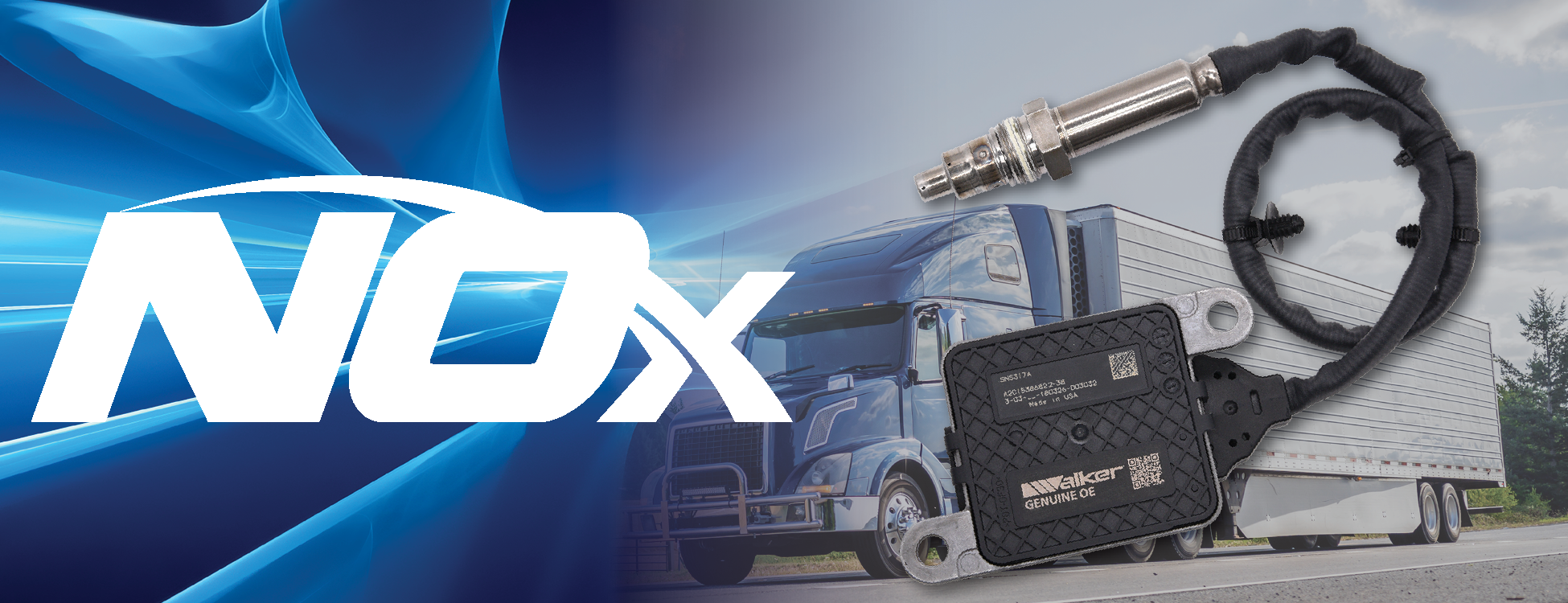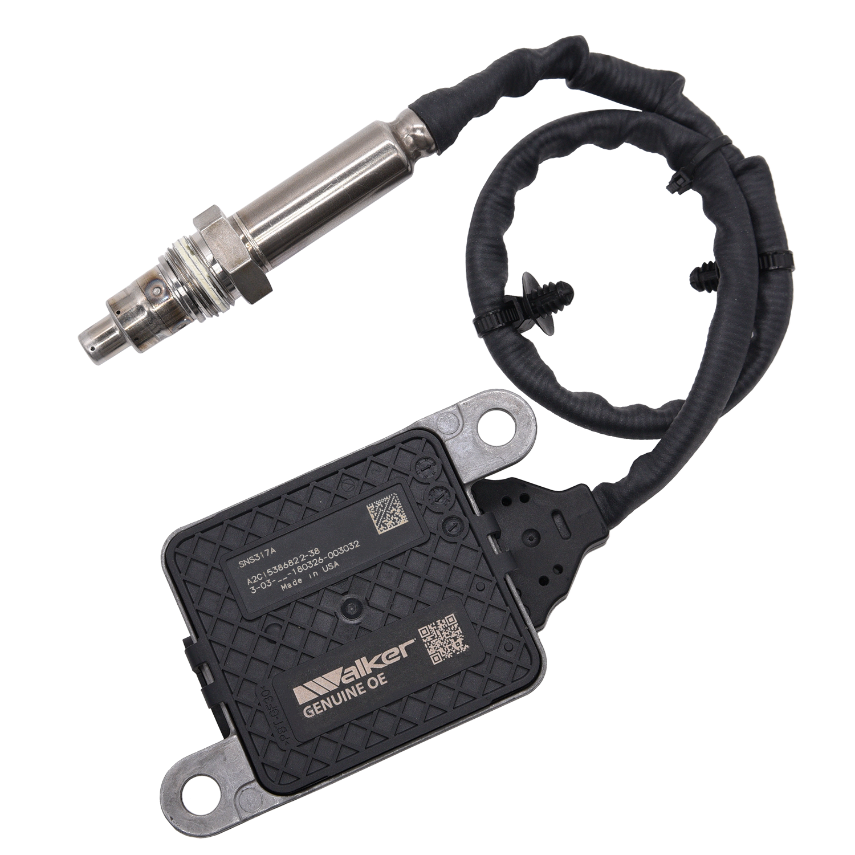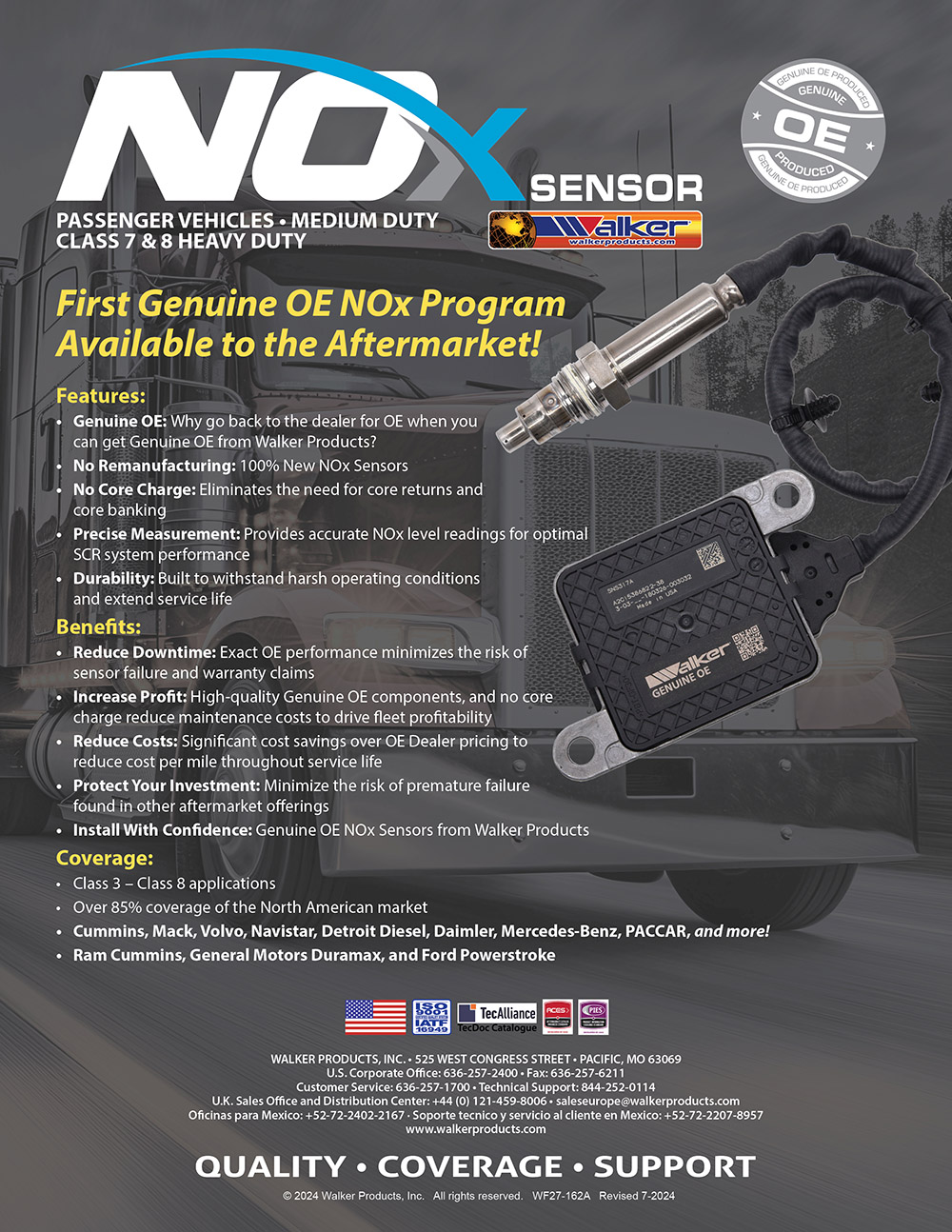
NOx Sensors
First Genuine OE NOx Program Available to the Aftermarket!
Walker Products proudly presents the first Genuine OE NOx program tailored for the aftermarket. Our NOx sensors are the top choice for Tier 1 quality, ensuring reliability and efficiency for your fleet maintenance needs. With our products, you benefit from components that are never remanufactured, ensuring no core charge, which reduces costs and maximizes profitability.
Coverage Across Leading Engine and Truck Brands
Cummins
– ISX Series
– ISB Series
– ISC Series
Mack
– MP7
– MP8
– MP10
Volvo
– D11
– D13
– D16
Detroit Diesel
– DD13
– DD15
– DD16

Development and Evolution:
NOx sensors play a critical role in modern automotive emission control systems. These sensors monitor the levels of nitrogen oxides (NOx) emitted by the engine and provide essential data for regulating combustion processes. NOx sensors are crucial for maintaining emissions compliance and optimal engine performance. They measure Nitrogen monoxide (NO), nitrogen dioxide (NO2), and nitrous oxide (N2O) levels in exhaust gases then send that information to the engine control module (ECM) for it to reduce emissions.
The development of NOx sensors began in the 1990s, and commercial sensors were introduced in the early 2000s. Initially, they were used on select lean burn stratified charge gasoline engines and diesel cars. Around 2010, NOx sensors became standard on light and heavy-duty vehicles equipped with selective catalytic reduction (SCR) systems. Today, NOx sensors are found in passenger cars, light-duty trucks, heavy-duty trucks, buses, construction equipment, and agricultural machinery.
Lifespan and Failure:
NOx sensors have a limited lifespan, typically between 100,000 to 150,000 miles. The longevity of these sensors is influenced by engine operating conditions. When a NOx sensor fails, faults are logged by the engine control module and displayed on the dashboard. In such cases, the engine may default to emergency mode, resulting in increased fuel consumption and slight stalls.
Causes of Failure:
• Soot buildup
• Excessive water in the exhaust stream
• Unburned fuel or carbon
Symptoms of Failing NOx Sensors:
• Increase fuel consumption
• Unstable idle
Manufactured in the USA with the highest quality materials, Walker’s NOx sensors are engineered and programmed to OE specifications for fit, form, and function. Unlike remanufactured alternatives, Walker Products NOx sensors are 100% Genuine OE NEW, making them the preferred choice for professional technicians nationwide. With coverage for Passenger Vehicles, Medium Duty, and Vocational, as well as Class 7 & 8 Heavy Duty trucks, Walker ensures quality, extensive coverage, and unwavering support.
To learn more about how you can partner with Walker Products on the industry’s leading NOx program, please contact our Customer Service or Sales Teams HERE.
SERVICE DETAILS
The following OBD II error codes are the most commonly found with this product type.
On-Board Diagnostic (OBD) systems are integrated into the computers of our vehicles to monitor emissions. The first generation of OBD requirements was implemented in California in 1988. Since then, these requirements were adopted by the US EPA for all passenger vehicles manufactured after 1996. In 2005, OBD systems then also became mandatory for heavy-duty vehicles and engines up to 14,000 lbs. GVWR. In 2008 the EPA finalized OBD regulations for 2010 and later heavy-duty engines used in highway vehicles over 14,000 lbs. GVWR and made changes to the OBD requirements for heavy-duty applications up to 14,000 lbs. GVWR to align them with requirements for applications over 14,000 lbs. GVWR.
OBD II is now the standard in diagnosing vehicle emissions in. The codes listed for this product type are common instances that may relate to your vehicle and should be used as a guide only. Walker Products will not be held responsible for any use of this information. It is highly suggested that you consult with a professionally trained mechanic prior to any automotive repair, and that you follow all vehicle manufacturer and EPA guidelines for removal, replacement, diagnostics, OBD II code clearing, ECU and PCM relearn procedures.
o P2000NOx Adsorber Efficiency Below Threshold
o P2001NOx Adsorber Efficiency Below Threshold
o P20ECSCR NOx Catalyst – Over Temperature
o P20EDSCR NOx Pre-Catalyst – Over Temperature
o P20EESCR NOx Catalyst Efficiency Below Threshold
o P20EFSCR NOx Pre- Catalyst Efficiency Below Threshold
o P20F0SCR NOx Catalyst – Over Temperature
o P20F1SCR NOx Pre-Catalyst – Over Temperature
o P20F2SCR NOx Catalyst Efficiency Below Threshold
o P20F3SCR NOx Pre- Catalyst Efficiency Below Threshold
o P2200NOx Sensor Circuit
o P2201NOx Sensor Circuit Range/Performance
o P2202NOx Sensor Circuit Low
o P2203NOx Sensor Circuit High
o P2204NOx Sensor Circuit Intermittent
o P2205NOx Sensor Heater Control Circuit/Open
o P2206NOx Sensor Heater Control Circuit Low
o P2207NOx Sensor Heater Control Circuit High
o P2208NOx Sensor Heater Sense Circuit
o P2209NOx Sensor Heater Sense Circuit Range/Performance
o P2210NOx Sensor Heater Sense Circuit Low
o P2211NOx Sensor Heater Sense Circuit High
o P2212NOx Sensor Heater Sense Circuit Intermittent
o P2213NOx Sensor Circuit
o P2214NOx Sensor Circuit Range/Performance
o P2215NOx Sensor Circuit Low
o P2216NOx Sensor Circuit High
o P2217NOx Sensor Circuit Intermittent
o P2218NOx Sensor Heater Control Circuit/Open
o P2219NOx Sensor Heater Control Circuit Low
o P2220NOx Sensor Heater Control Circuit High
o P2221NOx Sensor Heater Sense Circuit
o P2222NOx Sensor Heater Sense Circuit Range/Performance
o P2223NOx Sensor Heater Sense Circuit Low
o P2224NOx Sensor Heater Sense Circuit High
o P2225NOx Sensor Heater Sense Circuit Intermittent
o P2BA7NOx Exceedence – Empty Reagent Tank
o P2BA8NOx Exceedence – Interruption of Reagent Dosing Activity
o P2BA9NOx Exceedence – Insufficient Reagent Quality
o P2BAANOx Exceedence – Low Reagent Consumption
o P2BABNOx Exceedence – Incorrect EGR Flow
o P2BACNOx Exceedence – Deactivation of EGR
o P2BADNOx Exceedence – Root Cause Unknown
o P2BAENOx Exceedence – NOx control monitoring system
o U029DLost Communication With NOx Sensor “A”
o U029ELost Communication With NOx Sensor “B”
o U059EInvalid Data Received From NOx Sensor “A”
o U059FInvalid Data Received From NOx Sensor “B”
When troubleshooting engine sensors, it is recommended to look for any signs of visible damage first. Check all connections, starting with the sensor electrical connector, and look for any damage such as cracking or melting. Any damaged wires will need to be replaced.
The NOx Sensor is a sensor commonly mounted on the exhaust system before and after the Selective Catalyst Reducer (SCR).



